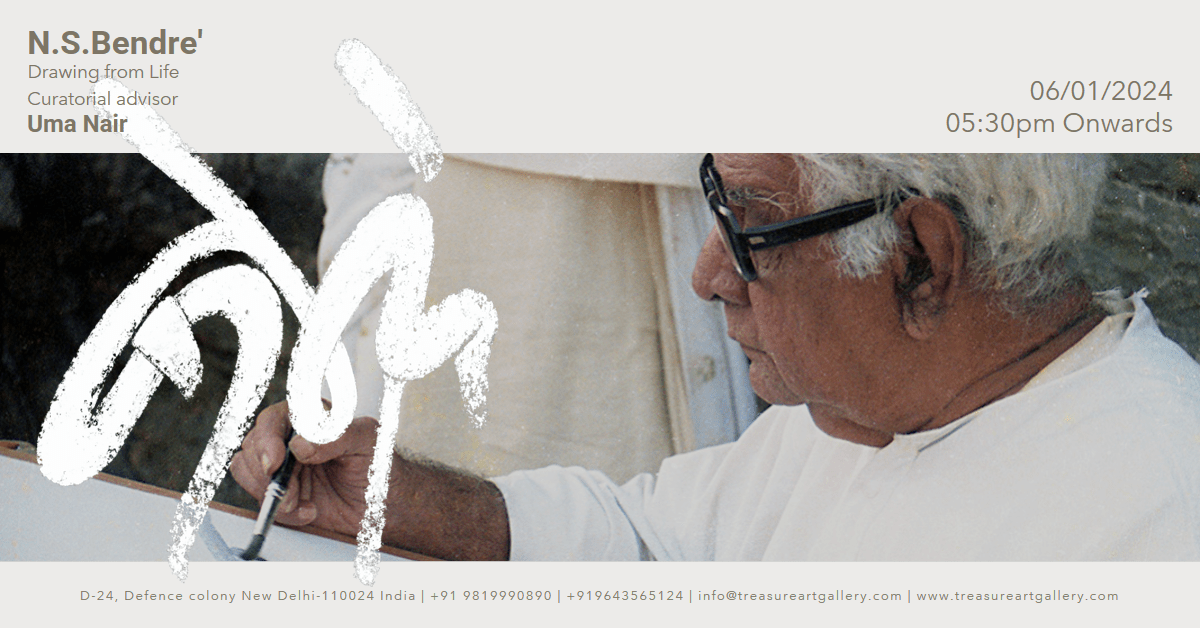
NS BENDRE : DRAWINGS FROM LIFE
Narayan Shridhar Bendre’s line drawings are arguably his simplest artworks, but they’re no less powerful as well as poignant reminders of his love for observing everyday idioms. Bendre’s lucid compositions and continuous line work is experimentation in its purest form, and even I their minimalist state , they remain some of his most popular artworks today other than his brilliant paintings.
Real life figures
Bendre took complex examples of real life figures on the streets, cows as well as animals and objects and reduced it to a few sparse broken as well as unbroken lines. Whilst they might look simple, capturing the true form of an object or person or animal is a challenge.The earliest drawing 1948 is that of a street with two women vendors with their ware on their heads and saris tucked in neatly, the bull with its wooden bow waiting in patient silence , as his dhoti clad master lights up a beedi. Ink on paper was Bendre’s staple in his orchestration of translating what he saw afresh on his sheets of paper.
It was the influence of primitive art in the early 20th century with its simple styling that led Bendre to create simple line drawings in his early as well as later years.The next image 1968 , is a study of six elephants done in solace and the beauty of capturing these gentle giants. Stripping it down to basics, line drawings seem to have allowed Bendre to focus on the relationship between observations of
artist and his subjects, removing colour, shade and composition from the equation. From the same year Rajasthan with a few camels sitting and ruminating is a minimal study of love for animals.
The 1970’s
From the 1970’s we see a series of deft strokes of cows their horns a delight to display. From 1975 is the figure of a lady sitting and working in the kitchen. Poise and posture and a constant reworking and redrawing of subjects was often used by Bendre as a beginning sketch in his creative process.
Studies of a single and a trio of seated young women all seem like a precursor to more detailed thoughts. Kutch with a series of Rajasthani women bring back memories of his famous Kutch paintings. The second Kutch painting is a mother and child in a humble hut.
Yet another work is that of a series of people. Languid and lithe lines work to keep an order amidst what is complete and incomplete. The mood is one of reverie.The 1978 ball pen sketch on paper is a beauty to behold as we look at the quartet of people sitting along with a child while two others come in smaller proportion in the foreground.
Landscapes from 1978-80
Bendre also sketched rambling landscapes that were created as a standalone work of art. An example of this is
seen in his feathery lines in which you can see how he worked away at the complex image of the landscape bit by bit reducing it to a single fluid line that still possessed all the beauty of landscape itself. Bendre’s single line drawings in these pen and ink drawings are so simple yet so powerful as they create so much of mood and emotive essence using few single broken lines.
Trio of 1983
Amidst 1983 trio of works we see a Kutch study of Rajasthani belles as well as a tree in a desert with rural rhythms and another tableau of cows and people. His love for drawing from life is seen in his absolute concentration on both subject as well as the idea that the translated image must be recognisable and as humble as possible.
Kerala and Kutch
From 1984 till the year 1987, Kerala and Kutch are both studies to ponder upon. Drawing was the absolute epicenter of Bendre’s artistic practice. It was his primary means of expression as seen in his Kutch drawing of women with children between huts in the desert as well as a group of women and children lying on the ground. The Kerala studies are replete with rhythms of lush tropicana as we look at the palm trees in paddy fields and the beaches of beauty and paradisal charm.The best Kerala study is a man and woman in conversation while the two palm trees and the canoe in the distance become the romantic symbolism
for the suggestion of the breeze that wafts across a melody in tunes of moody remembrance and reflection.
Amidst the Kerala studies we see his love for the trees and the still life study of the coconut palms that capture the leaves swaying in the breeze or just drooping on a humid afternoon. The little vignettes and vistas of the small roads and junctions in Kerala with the little cross at the roadside and the little hammock between two trees and the individual at the tap all become an album of
memories.Realistic insights were Bendre’s mainstay.
While Bendre was a brilliant painter too we see his sketches as a way of synthesising solutions that have been conceived and tested in the laboratory that is drawing.
Drawing as a mental laboratory
In a word, drawing was Bendre’s mental laboratory. Painting and colour never overtook the pictorial process completely in his work. Scholars and art historians say that drawing is used to test a concept, an idea, a theme, and once these are sharply defined and clarified, the artists very much like Pablo Picasso produce the end result in paint. Sometimes we see that drawings are produced in large format, so there’s not even necessarily a change of scale from drawing to painting.
What we realise when we see these drawings and sketches is that the pictorial output of NS Bendre basically consists of drawings rendered in pen and ink to an innate fibre of
integrity in his inner and outer eye. His entire oeuvre is conceived, anticipated and elaborated through drawing.
Bendre loved animals and many of these animals appeared in his works, and in particular his line drawings. He formed a particular attachment to cows, elephants and camels. They were immortalised in his line drawings.The simplicity, energy and life captured in Bendre’s line drawings perhaps explains the continued beauty and impact of these images. To express so much on single sheets of paper is a lot harder than it looks and is testament to Bendre’s artistic talent and love for drawing.
A generation of artists were inspired by Bendre’s minimalist line drawings. This exhibition, centred on the artist’s works on paper, brings into focus his life and art as it intersected with a network of family members, and friends. lovers. The many women whom he saw and observed inspired him and are frequently represented in his art, as are several friends and family members. He represented his subjects with both tenderness and appreciation of the trajectory of everyday living.
In an age where many artists are giving up drawing, this exhibition is a lesson that goes back to the drawing board.In many ways these sketches remind us of the great Pablo Picasso. To Pablo Picasso sketches served as a mean of discovery and engagement with masters from the past that in many ways contributed to the creation and the development of his unique art style. Throughout his life, the prolific artist created an array of hand drawings dealing
with a variety of topics including humans, animals, and mythological creatures. Since his university days, the artist used drawing to abstract his subjects by carefully removing their features one by one until they were reduced to only a few lines capturing the outlines of their anatomy.
Picasso’s words on drawing come alive.He said that:
Drawing is a kind of hypnotism: one looks in such a way at the model, that he comes and takes a seat on the paper.
In his later years, Pablo Picasso developed a single line drawing technique that was able to depict the very essence of his subject matter in only one opened line. The pencil sketches, that represent an essential skill for any artist, were changed and reinvented through constant reworking and redrawing of similar objects. Some were made as academic exercises and art studies for more complex works and some were executed as separate works of art but they all carry a unique elegance and energy that ensured them and undisputed popularity through centuries.
How curious that this brilliant painter, former Professor MS University Baroda , looked outward to supreme effect; how magnificent that he celebrated in the physicality of paint varied vignettes and symbols of the real connections of the pages of lived reality, which kept him united to Indian places, customs and people. These pages from his sketchbooks and drawings stand as lyrical odes to a post pandemic era in the capital city of Delhi.
As far as NS Bendre ‘s sketches are concerned, it’s safe to say that everyone has their favourite but Treasure Art Gallery has selected these sketches and line drawings as particularly beautiful and incredibly inspirational for this generation of art lovers to enjoy and peruse.
UMA NAIR
CRITIC & CURATOR
NEW DELHI
.
